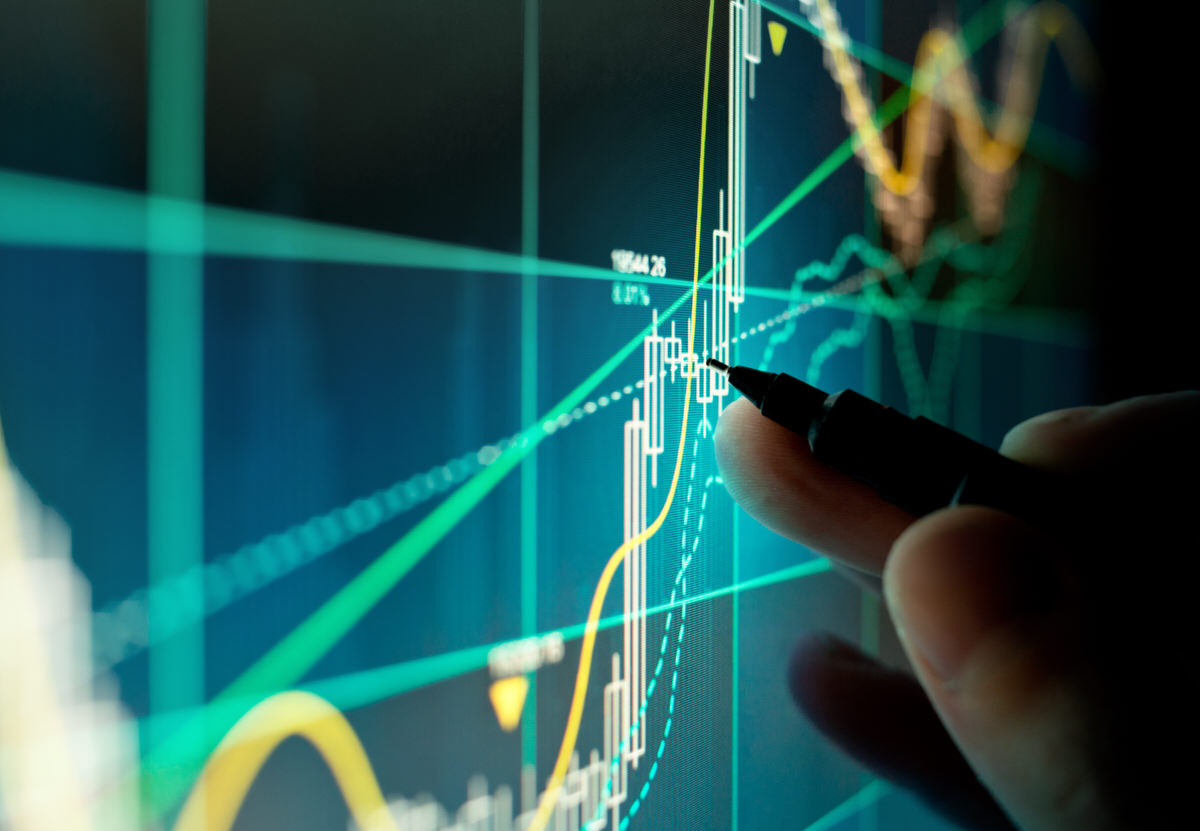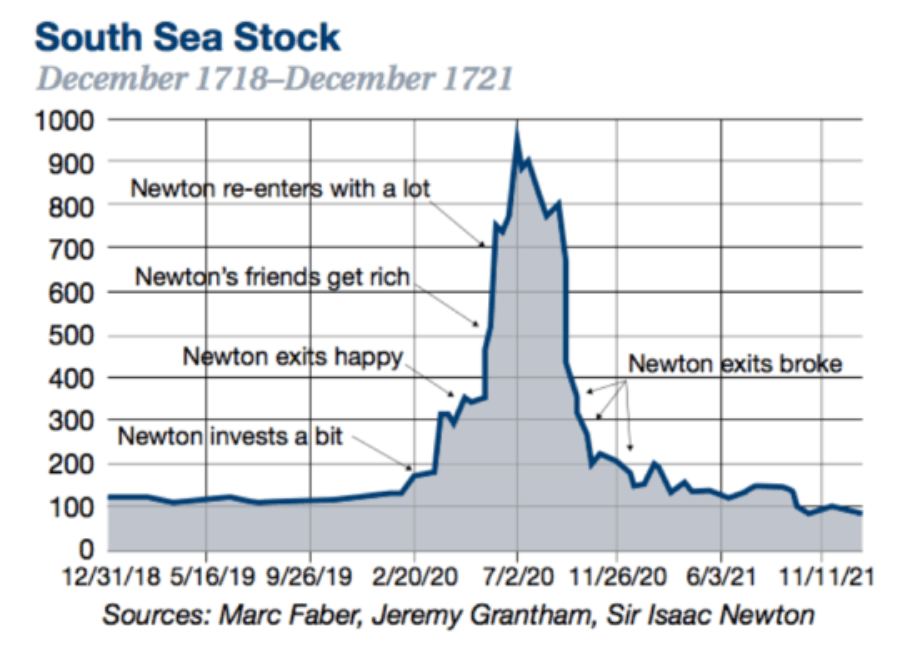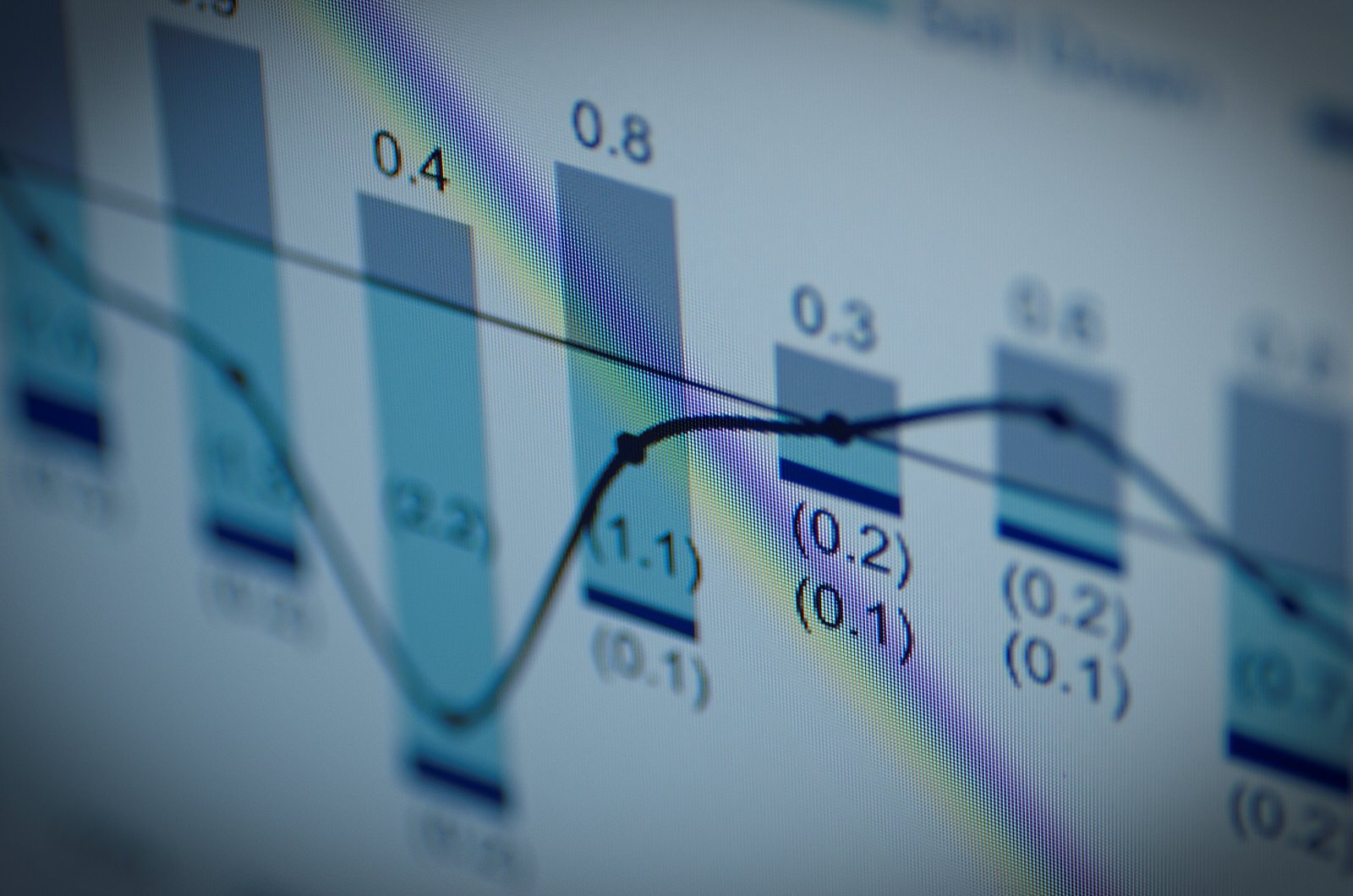by Lance Roberts, RIA
I have previously discussed the importance of understanding how “physics” plays a crucial role in the stock market. As Sir Issac Newton once discovered, “what goes up, must come down.”
Andy Kessler, via the Wall Street Journal, recently discussed a similar point with respect to the momentum in stock prices. To wit:
“Does this sound familiar: Smart guy owns stock in March at $200, sells it in June at around $600, but then buys it back in July and August for between $900 and $1,000. By September it’s back at $200. Ouch. Tesla this year? Yahoo in 2000? Nope. That was Sir Isaac Newton getting pulled into the great momentum trade of the South Sea Co., which cratered 300 years ago this month. He lost the equivalent of more than $3 million today. Newton, whose second law of motion is about the momentum of a body equaling the force acting on it, didn’t know that works for stocks too.”
To understand what happened to the South Sea Corporation, you need a bit of history.
The South Sea History
In 1720, in return for a loan of £7 million to finance the war against France, the House of Lords passed the South Sea Bill, which allowed the South Sea Company a monopoly in trade with South America.
England was already a financial disaster and was struggling to finance its war with France. As debts mounted, England needed a solution to stay afloat. The scheme was that in exchange for exclusive trading rights, the South Sea Company would underwrite the English National Debt. At that time, the debt stood at £30 million and carried a 5% interest coupon from the Government. The South Sea company converted the Government debt into its own shares. They would collect the interest from the Government and then pass it on to their shareholders.
Interesting Absurdities
At the time, England was in the midst of rampant market speculation. As soon as the South Sea Company concluded its deal with Parliament, the shares surged to more than 10 times their value. As South Sea Company shares bubbled up to incredible new heights, numerous other joint-stock companies IPO’d to take advantage of the booming investor demand for speculative investments.
Many of these new companies made outrageous, and often fraudulent, claims about their business ventures for the purpose of raising capital and boosting share prices. Here are some examples of these companies’ business proposals (History House, 1997):
- Supplying the town of Deal with fresh water.
- Trading in hair.
- Assuring of seamen’s wages.
- Importing pitch and tar, and other naval stores, from North Britain and America.
- Insuring of horses.
- Improving the art of making soap.
- Improving gardens.
- The insuring and increasing children’s fortunes.
- A wheel for perpetual motion.
- Importing walnut-trees from Virginia.
- The making of rape-oil.
- Paying pensions to widows and others, at a small discount.
- Making iron with pit coal.
- Transmutation of quicksilver into a malleable fine metal.
- For carrying on an undertaking of great advantage; but nobody to know what it is.
A Speculative Mania
However, in the midst of the “mania,” things like valuation, revenue, or even viable business models didn’t matter. It was the “Fear Of Missing Out,” which sucked investors into the fray without regard for the underlying risk.
Though South Sea Company shares were skyrocketing, the company’s profitability was mediocre at best, despite abundant promises of future growth by company directors.
The eventual selloff in Company shares was exacerbated by a previous plan of lending investors money to buy its shares. This “margin loan,” meant that many shareholders had to sell their shares to cover the plan’s first installment of payments.
As South Sea Company and other “bubble” company share prices imploded, speculators who had purchased shares on credit went bankrupt. The popping of the South Sea Bubble then resulted in a contagion that spread across Europe.
Newton’s Folly
Sir Issac Newton, the brilliant mathematician, was an early investor in South Sea Corporation. Newton quickly made a lot of money and recognized the early stages of a speculative mania. Knowing that it would eventually end badly, he liquidated his stake at a large profit.
However, after he exited, South Sea stock experienced one of the most legendary rises in history. As the bubble kept inflating, Newton allowed his emotions to overtake his previous logic and he jumped back into the shares. Unfortunately, it was near the peak.
It is noteworthy that once Newton decided to go back into South Sea stock, he moved essentially all his financial assets into it. In general, Newton was intimately familiar with commodities and finance. As Master of the Mint, his post required him to make many decisions that depended on market prices and conditions.
The story of Newton’s losses in the South Sea Bubble has become one of the most famous in popular finance literature. While surveying his losses, Newton allegedly said that he could “calculate the motions of the heavenly bodies, but not the madness of people.”
For More On The History Of Speculative Bubbles: “Devil Take The Hindmost.”
History Never Repeats, But It Rhymes
Throughout financial history, markets have evolved from one speculative “bubble,” to bust, to the next with each one being believed “it was different this time.”
The slides below are from a presentation I made to a large mutual fund company.
What we some common denominators between all previous bubbles and now.
The table below shows a listing of assets classes that have experienced bubbles throughout history, with the ones related to the current environment highlighted in yellow.
It is not hard to see the similarities between today and the previous market bubbles in history. Investors are currently chasing “new technology” stocks from Zoom to Tesla, piling into speculative call options, and piling into leverage. What could possibly go wrong?
Oh, by the way, the slides above are from a 2008 presentation just one month before the Lehman crisis.
The point here is that speculative cycles are always the same.
The Speculative Cycle
Charles Kindleberger suggested that speculative manias typically commence with a “displacement” which excites speculative interest. The displacement may come from either an entirely new object of investment (IPO) or from increased profitability of established investments.
The speculation is then reinforced by a “positive feedback” loop from rising prices. which ultimately induces “inexperienced investors” to enter the market. As the positive feedback loop continues, and the “euphoria” increases, retail investors then begin to “leverage” their risk in the market as “rationality” weakens.
The full cycle is shown below.
During the course of the mania, speculation becomes more diffused and spreads to different asset classes. New companies are floated to take advantage of the euphoria, and investors leverage their gains using derivatives, stock loans, and leveraged instruments.
As the mania leads to complacency, fraud and manipulation enter the market place. Eventually, the market crashes and speculators are wiped out. The Government and Regulators react by passing new laws and legislations to ensure the previous events never happen again.
The Latest Mania
Let’s go back to Andy for a moment:
“When bull markets get going, investors come out of the woodwork to pile in. These momentum investors—I call them momos—figure if a stock is going up, it will keep going up. But usually, there is some source of hot air inflating stocks: either a structural anomaly that fools investors into thinking ever-rising stock prices are real or a source of capital that buys, buys, buys—proverbial ‘dumb money.’ Think of it as a giant fireplace bellows, an accordion-like contraption that pumps in fresh oxygen to keep flames growing.” – Andy Kessler
We have seen these manias repeated throughout history.
- In 1929 you could buy stocks with as little as a 5% down payment
- The 1960s and ’70s had the Nifty Fifty bubble.
- In 1987 it was a rising dollar, portfolio insurance, and major investments by the Japanese into U.S. real estate.
- In 2000, it was the new paradigm of the internet and the influx of new online trading firms like E*Trade creating liquidity issues in Nasdaq stocks. Additionally, record numbers of companies were being brought public by Wall Street to fill investor demand.
- In 2008, subprime mortgages, low interest rates, and lax lending policies, combined with a litany of derivative products inflated massive bubbles in debt instruments.
In 2020?
What about today? Look back at the chart of the South Sea Company above. Now, the one below.
See any similarities.
Yes, that’s Tesla
However, you can’t solely blame the Federal Reserve as noted by Andy:
“Most simply blame the Federal Reserve—especially today, with its zero-interest-rate policy—for pumping the hot air that gets the momos going. Fair enough, but that’s only part of the story. Long market runs have always allured investors who figure they’re smart to jump in, even if it’s late.
Everyone forgets the adage, ‘Don’t mistake brains for a bull market.'”
This Time Is Different
As stated, while no two financial manias are ever alike, the end results are always the same.
Are there any similarities in today’s market? You decide.
- Robinhood Investors Discover 3x Leverage
- SPAC’s – Why Investors May Have Wished They Sold Sooner
- So Far In 2020, There Have Been 113 IPOs.
- Surge In Options Trading Drives Wall Street Gains
“From SPACs, or special purpose acquisition companies, which are modern-day blind pools that often don’t end well. Today’s momos also chase stock splits, which mean nothing for a company’s actual value. Same for a new listing in indexes like the S&P 500. Isaac Newton could explain the math.” – Andy Kessler
You get the idea. But one of the tell-tale indications is the speculative chase of “zombie” companies which are only still alive primarily due to the Federal Reserve’s interventions.
Fixing The Cause Of The Crash
Historically, all market crashes have been the result of things unrelated to valuation levels. Issues such as liquidity, government actions, monetary policy mistakes, recessions, or inflationary spikes are the culprits that trigger the “reversion in sentiment.”
Importantly, the “bubbles” and “busts” are never the same.
I previously quoted Bob Bronson on this point:
“It can be most reasonably assumed that markets are efficient enough that every bubble is significantly different than the previous one. A new bubble will always be different from the previous one(s). Such is since investors will only bid prices to extreme overvaluation levels if they are sure it is not repeating what led to the previous bubbles. Comparing the current extreme overvaluation to the dotcom is intellectually silly.
I would argue that when comparisons to previous bubbles become most popular, it’s a reliable timing marker of the top in a current bubble. As an analogy, no matter how thoroughly a fatal car crash is studied, there will still be other fatal car crashes. Such is true even if we avoid all previous accident-causing mistakes.”
Comparing the current market to any previous period in the market is rather pointless. The current market is not like 1995, 1999, or 2007? Valuations, economics, drivers, etc. are all different from cycle to the next.
Most importantly, however, the financial markets always adapt to the cause of the previous “fatal crash.”
Unfortunately, that adaptation won’t prevent the next one.
Yes, this time is different.
“Like all bubbles, it ends when the money runs out.” – Andy Kessler
Copyright © RIA





















